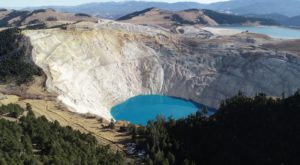By Derf Johnson
 Montana Tunnels is located south of Helena near Jefferson City. Photo via MTPR.
Montana Tunnels is located south of Helena near Jefferson City. Photo via MTPR.
In Montana, it’s a tale as old as time. A mining company gets a permit for a mine, exploits the land for several years, upstreams their valuable assets to a parent company, declares bankruptcy, and avoids the full costs of reclamation. Wash, rinse, repeat. Our history is replete with examples of these types of operations, littered across all four corners of the state. In listening to regulators and elected officials, one would think that our reclamation laws are adequate and protective, and that the historical examples are of a bygone era and can no longer occur. But the proof is in the pudding, and the pudding is poisoned.
Late last year, Montana Tunnels filed for Chapter 11 bankruptcy protection. The mine, located in Jefferson County just south of Helena, produced gold, silver, zinc, and lead in its heyday, but has not operated since 2008. Over the past several years, it became apparent that the reclamation activities at the mine had all but stalled and that the site was falling into disrepair. Clancy Creek, formally an excellent fishery, is now required to flow through a ¼ mile long plastic pipe in order to avoid being captured by the open pit, the highwall of which is now cracking, sluffing, and going to fail.
The unwinding stability at the Montana Tunnels site could have been avoided with adequate regulations, more frequent inspections, and an adequate bond. None of these happened. The Montana Department Environmental Quality (DEQ) estimated the full costs associated with the site to be at least $36.5 million. However, the current bond held by DEQ amounts to only $19.7 million, leaving a $17 million shortfall of required reclamation funds. Montana Tunnels’ bankruptcy filing raises serious doubts about whether the company will ever be held responsible for the additional costs associated with reclamation at the site.
One would think that, with yet another round of history repeating itself, regulators and policymakers would be proactive about addressing what actually went wrong at Montana Tunnels. Unfortunately, the Montana Legislature, the primary entity responsible for the mess in the first place, doesn’t see a problem here. There are not currently any legislative proposals to beef up or otherwise improve hardrock mine bonding requirements at Montana’s mines. In fact, in legislative sessions over the past decade, there have been proposals to improve Montana’s reclamation bonding laws, but all of them have failed by the request of industry (and in some cases, DEQ).
Reclamation after mining is the cost of doing business in this state. Our Constitution also clearly requires that all lands disturbed by natural resources extraction be reclaimed. Sadly, this promise in our Constitution has not been kept. Hopefully, this is the last time MEIC will ever have to write about another mine with underfunded reclamation responsibilities that declares bankruptcy. Sadly, that is unlikely to be the case, and the state’s current “path” all but assures it.
This article was published in the March 2023 issue of Down To Earth.

